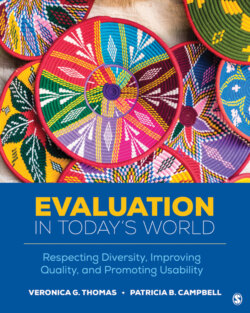Читать книгу Evaluation in Today’s World - Veronica G. Thomas - Страница 71
На сайте Литреса книга снята с продажи.
Ethical Dimension of Racial Bias
ОглавлениеRace is only one of many cultural constructs. However, it is a powerful one in American society and one that deserves special attention. Race, as a socially constructed phenomenon, continues to differentially shape the allocation of power and distribution of benefits and burdens among groups within the United States. When considering the prominent ills (e.g., poverty, crime, education gaps, health disparities) of the country, race is always a factor in the equation. Over two decades ago, Patton (1999) questioned how the lens of race shapes and affects evaluators’ understanding and actions. This question still has relevance today.
Racism can be a complex and destructive force in the evaluation context. Evaluators have an ethical obligation to eliminate, or at least mitigate, racial (and other) biases in their work. In 2018, Thomas, Madison, Rockcliffe, DeLaine, and Lowe called for evaluators to use their power and privilege to advance a more equitable society by “calling out” racial biases, policies, and practices and unmasking power inequities and outcomes of people in programs within the context of their racialized environments. Racial bias, particularly as it relates to African Americans, is due in large part to their unique historical position in the United States, and it can be present in both evaluators and evaluation stakeholders such as funders, policymakers, program staff, and others.
Biased conceptions of race can hinder an evaluator’s ability to evaluate culturally and socially different worlds and realities. This, in turn, can prevent an evaluator from rendering ethical, honest, and fair evaluations. As discussed in Chapter 1, implicit bias, or unconscious attitudes and stereotypes, can affect evaluators’ understanding, decisions, and actions in a manner that lends itself to questionable ethical conduct. Such biases are activated involuntarily and without an individual’s awareness or intentional control. Many people do not deliberately discriminate against others, but when they offer preferential treatment to those who are like them, whom they know, and/or whom they like or feel most comfortable with, the resulting outcome can be unconscious bias and discrimination against those who are different. Individuals typically fail to recognize the harm that implicit favoritism of in-group members causes to members of the social out-groups (Sezer, Gino, & Bazerman, 2015). Evaluators, like other professionals and laypersons, are not immune to implicit biases. In the article “Evaluation and the Framing of Race,” House (2017, p. 188) pointed out that
a common error of evaluations is that the conclusions of the study don’t fit the data on which they’re based. This is more likely when the evaluations involve minorities. We need to weigh the empirical evidence carefully against the conclusions. Inferences from data to conclusions are particularly susceptible to bias because they’re based on more background knowledge than just the study.
Evaluators should be prepared for racial biases (House, 2017). As House and others point out, majority evaluators are often poorly informed and even misinformed about minorities and thus ill equipped to evaluate projects serving communities of color. As a result, various scholars have called for use of evaluation approaches, such as those that are culturally responsive, contextually responsive, culturally competent, and transformative and that emphasize inclusiveness, pluralism, and better understanding of minority cultures on the part of majority evaluators (e.g., Frierson, Hood, Hughes, & Thomas, 2010; Hood, Hopson, & Frierson, 2005, 2015; Hopson, 2009; Mertens, 2009; Samuels & Ryan, 2011; Thomas & Stevens, 2004; Thompson-Robinson, Hopson, & SenGupta, 2004). House (2017) calls for (majority) evaluators to check their own predispositions, arguing that no white person growing up in this country can be entirely free of racial framing. He also stresses that evaluators should check the work of their colleagues for such dispositions. Evaluators can be “critical friends” and look for biases that evaluators might harbor in their beliefs, dispositions, and behavior given that such biases can significantly affect evaluation findings (House, 2017, p. 187). This is indeed an ethical responsibility for evaluators.
